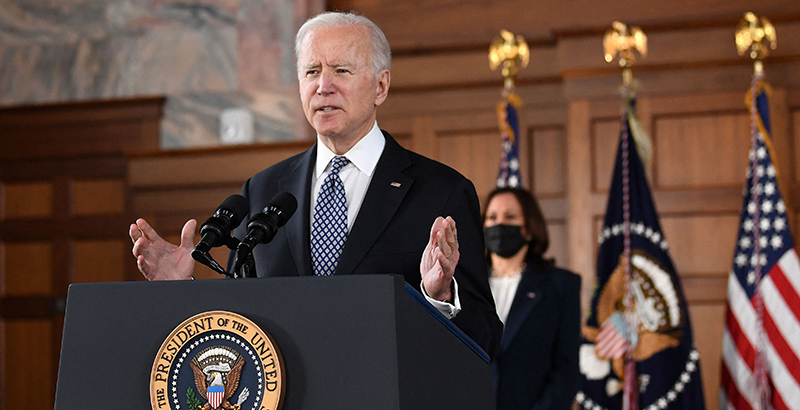Petrilli: Biden Wants Free Community College — But Also Better High School-to-Career Pathways. Is He on to Something?

Get essential education news and commentary delivered straight to your inbox. Sign up here for The 74’s daily newsletter.
At first blush, President Joe Biden’s proposals related to postsecondary education and jobs creation are a total mishmash, a bowl of spaghetti thrown at the wall. But if we’re honest with ourselves, we will acknowledge that he and his team are not the only ones whose thoughts on students’ post-high school plans are tangled. Now’s a good time for some straight talk and clear thinking about what it means to help all of our young people succeed in early adulthood and beyond.
For many years, education reform dogma insisted that college, or at least some sort of postsecondary education, is necessary for young people to have a shot at the middle class and the American dream. Indeed, Biden echoed that view last week, when he called for free community college, because “12 years is no longer enough today, to compete with the rest of the world in the 21st century.”
There’s been some movement in ed reform circles in making sure career and technical programs are also valued, not just traditional college prep ones. Still, so far it’s more talk than action. As education expert Marc Tucker explains, “fewer than 5 percent of high school students in most states leave with a qualification that is honored by employers” — a number that could and should be five or 10 times higher, at least if we think that other prosperous, advanced countries have something to teach us.
But where we continue to be most confused and dishonest is around what constitutes success for students who leave high school and go straight into the workforce.
I don’t think it’s inaccurate to say many reformers view such an outcome as a failure, especially for poor kids and kids of color. Indeed, many states’ accountability systems under The Every Student Succeeds Act include some sort of “college and career ready” index that marks high schools down for sending graduates straight into the labor market. And that’s because of overwhelming evidence that it’s really hard to make a decent wage with nothing but a high school diploma.
But what if that were no longer the case? Most of us have assumed that the 1950s-era economy is never coming back, that there’s no longer such a thing as a “good-paying low-skill job.” Thanks to globalization, automation and the shift to a service-sector economy, those are just the facts of life.
But here comes Biden saying: not so fast. Maybe it is possible to bring back good-paying blue collar (and pink collar) jobs that don’t require much postsecondary education. He made that claim as well last week, saying, “nearly 90 percent of the infrastructure jobs created in the American Jobs Plan do not require a college degree. Seventy-five percent don’t require an associate’s degree.”
So which of his statements is true? Is it the case that 12 years of education are no longer enough, and so everyone should obtain another two years of college on top? Or is it the case that, with enough federal leadership and determination, we can bring back (or create) millions of jobs that pay well and require only a high school diploma?
It’s just not just new infrastructure jobs that Biden is talking about. He is also pushing to raise the minimum wage, if not for everyone, then at least for child care workers. He also promises to support low-wage workers by expanding the earned income tax credit and the child tax credit, not to mention free preschool, more generous supports for child care and the rest of the blizzard of safety net and welfare-state benefits he is proposing.
The point is that Biden wants to make it possible to live a decent life in America without much, if any, higher education. And perhaps we should welcome such a call. After all, it’s not like today’s K-12 system is getting anywhere close to preparing all students to succeed in postsecondary education; it’s not even getting half of students to that mark. In fact, that’s the most problematic part (among many) of Biden’s call to make community college free: It misdiagnoses the reason why so few young Americans complete programs at those institutions. Sure, more would enter and remain and probably graduate if there were no tuition. But the major reason by far that so many teenagers don’t matriculate in community college, or enroll but then drop out, is that they lack the reading, writing and mathematics skills to succeed. College, community or otherwise, just isn’t a good option for young people whose skills are at a middle school level.
As a committed education reformer, I wish Biden would focus more on K-12 reboots, especially in reimagining how high schools might get many more students to college readiness levels by the end of 12th grade, as well as giving many more students a chance to get started on serious career tech and apprenticeship programs before they graduate. Boosting the percentage of students who leave high school with the skills — academic and otherwise — to succeed in some sort of postsecondary program should remain a key priority for education policy and practice in the years ahead.
But we should also take some cues from Biden and stop denigrating the straight-into-the-workforce pathway. As we were reminded over the past year, so-called “low skill” jobs are super important to our society. And they can be their own form of postsecondary education, as young people gain on-the-job skills that will lead to better wages, and more opportunities, going forward. Such opportunities might even include college — down the road, when some people might be more prepared to make the most of it. So let’s start showing more respect for low-wage work, and celebrate moves to supplement those wages to help people live better lives too.
Michael J. Petrilli is president of the Thomas B. Fordham Institute and a visiting fellow at the Hoover Institution.
Get stories like these delivered straight to your inbox. Sign up for The 74 Newsletter

;)
